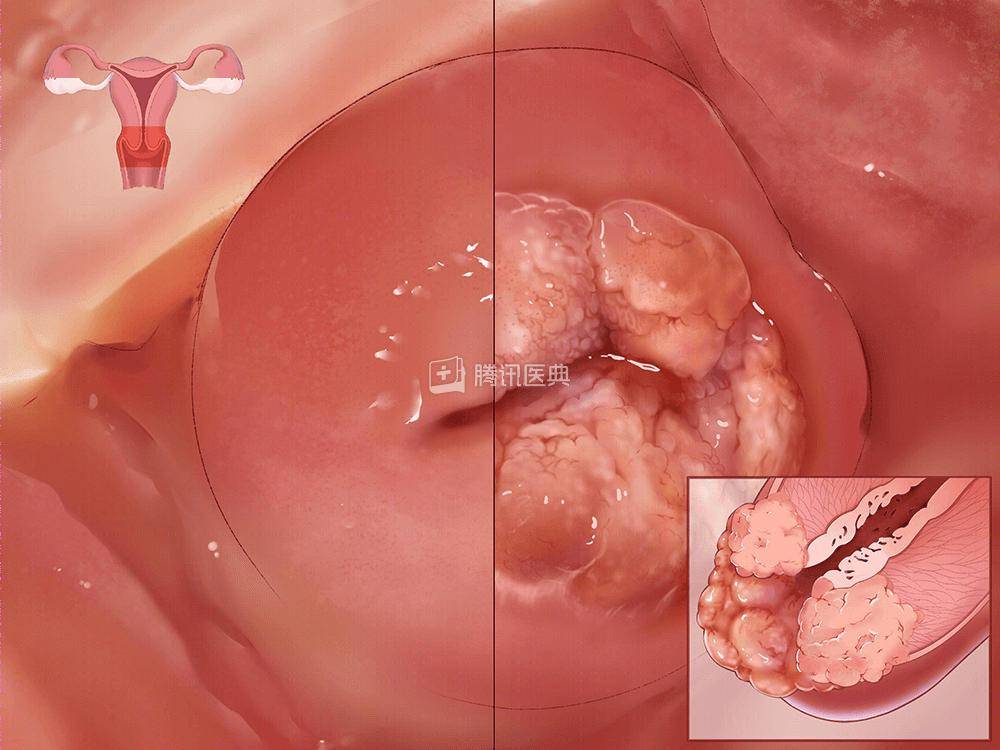Many young ladies tremble when they see the cervical scraping test on their examination report during gynecological check-ups. The term “cervical scraping” sounds painful, so what exactly does this test reveal? Is it really necessary to undergo?
Cervical scraping is actually a method for cervical cancer screening, able to detect early-stage cervical cancer or precancerous lesions.
If such lesions are detected early, they can generally be cured through simple treatments.
Since the causes of cervical cancer are quite clear and the progression from abnormal cells to cancer takes about 8-10 years, regular screenings and early detection are crucial for preventing and treating cervical cancer in women!
The image below shows the appearance after cervical cancer transformation.
▼
In simple terms, cervical scraping involves gently rotating a specialized small scraper or brush in the cervical area for 1-2 weeks, collecting some cervical cells to observe for abnormalities under a microscope.
TCT examination, also known as cervical thin-layer liquid-based cell detection, involves using a sampler to repetitively rotate in the cervical area to collect shed cervical cells and prepare smears.
The prepared smears appear clearer and represent the most advanced screening method for cervical cancer cell studies.
It can be said that nowadays, most cervical scraping tests are actually TCT (liquid-based thin-layer cell examination).
This examination method generally does not cause damage to the cervix, only mild discomfort may be experienced.
Some women may experience a slight bloody discharge or minor bleeding after the sampling, these are normal occurrences, do not be frightened by the term “scraping.”
Not all women need to undergo cervical scraping tests, according to current cervical cancer screening guidelines[3]:
Women aged ≥21 years and sexually active can start cervical cancer screening; women with other risk factors may need to do it earlier based on doctor’s recommendation.
For women under 21 years of age, regardless of sexual activity or other risk factors, routine screening is not recommended.
Different age groups have different recommended screening protocols:
It is important to note that the HPV vaccine is not a tool to avoid screening; even with HPV vaccination, it cannot 100% prevent cervical cancer!
Regular cervical screening is still necessary to reduce the risk of cervical cancer occurrence.
What are the precautions for cervical scraping examination?
Conduct the examination outside menstruation. The best time for examination is right after the menstrual period when the cells are clearer under the microscope.
Do not perform vaginal flushing before the examination. Some women may douche their vagina before a gynecological visit to avoid unwanted substances and odors, but this can disrupt the vaginal microenvironment and affect the examination results.
Avoid using vaginal medications before the examination, such as suppositories for treating vaginal inflammation, etc.
Avoid sexual activity 48 hours before the examination.
Despite mustering the courage to undergo the examination, the medical report filled with professional terminology can be intimidating.
Don’t panic! Understanding the following possible results[4] on the report can help you interpret the diagnosis, and you won’t need help deciphering the report anymore.
(Source: Internet)
1. No intraepithelial or malignant lesions: This is the result everyone hopes to see, indicating no abnormal cells in the smear.
2. Inflammation: When this result appears, it often suggests a disruption in the normal vaginal flora, or the presence of pathogenic microorganisms like trichomonas causing infection. It is recommended to undergo routine vaginal discharge and bacterial vaginal infection examinations, followed by treatment based on the results.
3. Atypical squamous cells (ASC): These cells appear normal yet abnormal, making it difficult to definitively define. When this result is observed, it is likely transient inflammation causing it, and a repeat smear examination after 3-6 months can be considered.
4. Squamous intraepithelial lesion (SIL): Indicates the presence of abnormal cells, and immediate colposcopy and cervical biopsy are recommended to further evaluate the condition.
5. Squamous cell carcinoma (SCC) and adenocarcinoma (AC): Signify a higher risk of cervical cancer, requiring prompt medical attention.
Understanding these outcomes will not only alleviate fears around “scraping” itself but also prevent being intimidated by the test results.
Cervical scraping results are only a screening; they do not provide a final diagnosis. So, even if the report shows unfavorable results, remain calm as it is an early alert to potential health issues, prompting further investigations.
Cervical scraping safeguards health at minimal cost. Let’s overcome mental barriers, not fear “scraping,” and prevent cervical cancer from arising. May the female world be free from cervical cancer!
Review Expert
Cui-Ping Feng | Deputy Chief Physician in Obstetrics, China-Japan Friendship Hospital
References
[1] Yan Q, 3128 cases of gynecological cervical scraping cytology examination result analysis. Modern Diagnosis and Treatment, 2012, 23(05): 506-507.
[2] Song D, Kong W, Zhang T, Jiao S, Chen J, Shang R, Liu Y, Li X. Study on the relationship between high-risk HPV turning negative and prognosis after cervical cancer treatment. Chinese Journal of Practical Gynecology and Obstetrics, 2017, 33(09): 975-978.
[3] Curry SJ, Krist AH, Owens DK, et al. Screening for cervical cancer: US preventive services task force recommendation statement. JAMA, 2018, 320(7): 674-686.
[4] Mo C. Application value of colposcopy and cervical scraping cytology examination in the survey and diagnosis of cervical lesions in 1991 women. China Maternal and Child Health, 2017, 32(02): 399-401.
Content Production
*Produced by Tencent Medictionary Content Team
Past Recommendations


